Compounding Effects of Fluvial Flooding and Storm Tides on Coastal Flooding Risk in the Coastal-Estuarine Region of Southeastern China
Abstract
:1. Introduction
2. Materials and Methods
2.1. Study Area and Data
2.2. Methodology
2.2.1. Extraction of Compound Flood Events
2.2.2. Construction of Bivariate Probability Distribution
- Univariate analysis: McVAT was used to select the “best” marginal univariate distributions and , respectively. McVAT employs 17 different continuous marginal distribution functions (Beta, Birnbaum-Saunders, Exponential, Extreme value, Gamma, Generalized extreme value, Generalized Pareto, Inverse Gaussian, Logistic, Log-logistic, Lognormal, Nakagami, Normal, Rayleigh, Rician, T location-scale and Weibull) as candidate marginal distributions. The distribution functions are given in Table S1. The parameters of all candidate marginal distributions were estimated through a maximum likelihood algorithm based on observed time series of one variable. Kolmogorov–Smirnov goodness-of-fit test [57] was then employed to statistically examine the hypothesis that data was sampled from the fitted distribution at 5% significance level. The “best” marginal univariate distribution was picked out from non-rejected candidate marginal distributions based on the Akaike information criterion (AIC) [58]. Nash–Sutcliffe efficiency (NSE) between theoretical and empirical probabilities [56] was applied to evaluate the performance of fitted marginal univariate distribution.
- Dependency analysis: The estimates of the Kendall Rank correlation coefficient [59] was computed between river discharge X and sea level Y, and, also, the corresponding independence tests was assessed at 10% significance level. If the p-value is larger than 10%, river discharge X and sea level Y are independent. Otherwise, they are significantly correlated.
- Bivariate Analysis: If river discharge X and sea level Y were correlated, McVAT providing 26 copula functions were used as candidate bivariate distributions. The candidate bivariate distributions include Gaussian, T, Clayton, Frank, Gumbel, Independence Ali–Mikhail–Haq, Joe, Farlie–Gumbel–Morgenstern, Gumbel–Barnett, Plackett, Cuadras–Auge, Raftery, Shih–Louis, Linear-Spearman, Cubic, Burr, Nelsen, Galambos, Marshall–Olkin, Fischer–Hinzmann, Roch–Alegre, Fischer–Kock, BB1, BB5 and Tawn copula functions. The equation of these functions can be found in [56]. The parameters of all candidate bivariate distributions were estimated by a Bayesian framework with a residual-based Gaussian likelihood function. Cramér–von Mises (CM) test was used to goodness of fit test of copula functions. Consistent with univariate analysis, the “best” copula function was chosen from non-rejected candidate couple functions on the Akaike information criterion (AIC) and NSE was applied to evaluate the performance of fitted copulas.
- Construction of bivariate probability distribution: if river discharge X and sea level Y are independent, then the bivariate probability distribution can be described by independent joint distribution as:where and are “best” marginal univariate distributions.If river discharge X and sea level Y were correlated, the bivariate probability distribution can be described as Equation (1). The copula C in Equation (1) is replaced with the “best” copula function and in Equation (1) are replaced with and , respectively.
2.2.3. Modeling a Flood Typing-Based Bivariate Distribution
2.2.4. Bivariate Return Period and Bivariate Design Value
3. Results
3.1. Bivariate Probability Distribution of Compound Flood Events
3.2. Compound Flood Events per Flood Type
3.3. Impacts of Mixed Flood-Generating Mechanisms on Bivariate Probability Distribution
3.4. Compounding Effects on Bivariate Return Period and Bivariate Design Value
4. Discussion
5. Conclusions
- (1)
- With regard to compound flood events per flood type, the percentages of TC-induced flood events ranged from 18% to 55%, while that of non-TC-induced flood events ranged from 49% to 72%. The percentages of mixed-induced flood events were below 25%. Non-TC-induced flood occupied larger proportions in in the coastal area of China mainland (all coastal-estuarine regions except Longtang, Jiaji and Baoqiao), while non-TC floods dominated in Hainan Island (including Longtang, Jiaji and Baoqiao). The highest percentages of TC-induced floods appeared in August, while that of non-TC-induced floods appeared in June. However, mixed floods mostly occurred in both June and August. The seasonality of three flood types were different, which confirms the necessity to analyze the impact of mixed flood-generating mechanisms on bivariate probability distribution.
- (2)
- MvCAT combined with goodness-of fit tests were used to construct bivariate probability distributions in 15 coastal-estuarine regions of Southeastern China and a flood typing-based bivariate distribution was built in 15 coastal-estuarine regions. In 11 out of 15 coastal-estuarine regions, the flood typing-based bivariate distribution still performs better than the bivariate probability distribution in terms of NSE values. However, in the other 4 coastal-estuarine regions, it comes to the contradictory conclusion. The performance of flood typing-based bivariate distribution was not significantly better than the bivariate probability distribution in coastal-estuarine regions based on the Mann–Whitney U test. The applicability of the flood typing-based bivariate distribution varied in different regions, and hence, the benefit of the higher NSE and the disadvantage of the larger uncertainty have to be balanced.
- (3)
- The compounding impacts of river discharge and sea level had limited impact on bivariate return periods, whereas had greater impact on coastal flooding risk in terms of design values. In terms of design values, either the design river discharge or design sea level in consideration of compounding effects of river discharge and sea level was larger than that when neglecting compounding effects. Ignoring compounding effects of river discharge and sea level leads to significant underestimation of design values. Comparing with design sea level, the compounding effects of river discharge and sea level had stronger influence on design river discharge.
Supplementary Materials
Author Contributions
Funding
Institutional Review Board Statement
Informed Consent Statement
Data Availability Statement
Acknowledgments
Conflicts of Interest
References
- Emanuel, K. Increasing destructiveness of tropical cyclones over the past 30 years. Nature 2005, 436, 686–688. [Google Scholar] [CrossRef] [PubMed]
- Webster, P.J.; Holland, G.J.; Curry, J.A.; Chang, H.R. Changes in tropical cyclone number, duration, and intensity in a warming environment. Science 2005, 309, 1844–1846. [Google Scholar] [CrossRef] [PubMed] [Green Version]
- Woodruff, J.D.; Irish, J.L.; Camargo, S.J. Coastal flooding by tropical cyclones and sea-level rise. Nature 2013, 504, 44–52. [Google Scholar] [CrossRef] [PubMed] [Green Version]
- Kew, S.F.; Selten, F.M.; Lenderink, G.; Hazeleger, W. The simultaneous occurrence of surge and discharge extremes for the Rhine delta. Nat. Hazards Earth Syst. Sci. 2013, 13, 2017–2029. [Google Scholar] [CrossRef] [Green Version]
- Moftakhari, H.R.; Salvadori, G.; AghaKouchak, A.; Sanders, B.F.; Matthew, R.A. Compounding effects of sea level rise and fluvial flooding. Proc. Natl. Acad. Sci. USA 2017, 114, 9785–9790. [Google Scholar] [CrossRef] [Green Version]
- Zscheischler, J.; Westra, S.; van den Hurk, B.J.J.M.; Seneviratne, S.I.; Ward, P.J.; Pitman, A.; AghaKouchak, A.; Bresch, D.N.; Leonard, M.; Wahl, T.; et al. Future climate risk from compound events. Nat. Clim. Chang. 2018, 8, 469–477. [Google Scholar] [CrossRef]
- Klerk, W.J.; Winsemius, H.C.; van Verseveld, W.J.; Bakker, A.M.R.; Diermanse, F.L.M. The co-incidence of storm surges and extreme discharges within the Rhine–Meuse Delta. Environ. Res. Lett. 2015, 10, 035005. [Google Scholar] [CrossRef] [Green Version]
- Wahl, T.; Jain, S.; Bender, J.; Meyers, S.D.; Luther, M.E. Increasing risk of compound flooding from storm surge and rainfall for major US cities. Nat. Clim. Chang. 2015, 5, 1093–1097. [Google Scholar] [CrossRef]
- Zhang, W.; Chang, W.J.; Zhu, Z.C.; Hui, Z. Landscape ecological risk assessment of Chinese coastal cities based on land use change. Appl. Geogr. 2020, 117, 102174. [Google Scholar] [CrossRef]
- Jongman, B.; Ward, P.J.; Aerts, J.C.J.H. Global exposure to river and coastal flooding: Long term trends and changes. Glob. Environ. Chang. 2012, 22, 823–835. [Google Scholar] [CrossRef]
- Hinkel, J.; Lincke, D.; Vafeidis, A.T.; Perrette, M.; Nicholls, R.J.; Tol, R.S.J.; Marzeion, B.; Fettweis, X.; Ionescu, C.; Levermann, A. Coastal flood damage and adaptation costs under 21st century sea-level rise. Proc. Natl. Acad. Sci. USA 2014, 111, 3292–3297. [Google Scholar] [CrossRef] [PubMed] [Green Version]
- Neumann, B.; Vafeidis, A.T.; Zimmermann, J.; Nicholls, R.J. Future Coastal Population Growth and Exposure to Sea-Level Rise and Coastal Flooding—A Global Assessment. PLoS ONE 2015, 10, e0118571. [Google Scholar] [CrossRef] [PubMed] [Green Version]
- Zheng, F.; Leonard, M.; Westra, S. Application of the design variable method to estimate coastal flood risk. J. Flood Risk Manag. 2017, 10, 522–534. [Google Scholar] [CrossRef]
- Kasiviswanathan, K.S.; He, J.; Tay, J.-H. Flood frequency analysis using multi-objective optimization based interval estimation approach. J. Hydrol. 2017, 545, 251–262. [Google Scholar] [CrossRef]
- Salvadori, G.; De Michele, C. Frequency analysis via copulas: Theoretical aspects and applications to hydrological events. Water Resour. Res. 2004, 40. [Google Scholar] [CrossRef]
- De Michele, C.; Salvadori, G.; Canossi, M.; Petaccia, A.; Rosso, R. Bivariate statistical approach to check adequacy of dam spillway. J. Hydrol. Eng. 2005, 10, 50–57. [Google Scholar] [CrossRef]
- Svensson, C.; Jones, D.A. Dependence between sea surge, river flow and precipitation in south and west Britain. Hydrol. Earth Syst. Sci. 2004, 8, 973–992. [Google Scholar] [CrossRef] [Green Version]
- Zheng, F.; Westra, S.; Sisson, S.A. Quantifying the dependence between extreme rainfall and storm surge in the coastal zone. J. Hydrol. 2013, 505, 172–187. [Google Scholar] [CrossRef]
- Xu, H.; Xu, K.; Lian, J.; Ma, C. Compound effects of rainfall and storm tides on coastal flooding risk. In Stochastic Environmental Research and Risk Assessment; Springer: Berlin/Heidelberg, Germany, 2019. [Google Scholar]
- Ganguli, P.; Paprotny, D.; Hasan, M.; Güntner, A.; Merz, B. Projected Changes in Compound Flood Hazard from Riverine and Coastal Floods in Northwestern Europe. Earth’s Future 2020, 8, e2020EF001752. [Google Scholar] [CrossRef]
- Couasnon, A.; Eilander, D.; Muis, S.; Veldkamp, T.I.E.; Haigh, I.D.; Wahl, T.; Winsemius, H.C.; Ward, P.J. Measuring compound flood potential from river discharge and storm surge extremes at the global scale. Nat. Hazards Earth Syst. Sci. 2020, 20, 489–504. [Google Scholar] [CrossRef] [Green Version]
- Eilander, D.; Couasnon, A.; Ikeuchi, H.; Muis, S.; Yamazaki, D.; Winsemius, H.C.; Ward, P.J. The effect of surge on riverine flood hazard and impact in deltas globally. Environ. Res. Lett. 2020, 15, 104007. [Google Scholar] [CrossRef]
- Santos, V.M.; Casas-Prat, M.; Poschlod, B.; Ragno, E.; van den Hurk, B.; Hao, Z.; Kalmár, T.; Zhu, L.; Najafi, H. Statistical modelling and climate variability of compound surge and precipitation events in a managed water system: A case study in the Netherlands. Hydrol. Earth Syst. Sci. 2021, 25, 3595–3615. [Google Scholar] [CrossRef]
- Sanuy, M.; Rigo, T.; Jiménez, J.A.; Llasat, M.C. Classifying compound coastal storm and heavy rainfall events in the north-western Spanish Mediterranean. Hydrol. Earth Syst. Sci. 2021, 25, 3759–3781. [Google Scholar] [CrossRef]
- Wu, W.; McInnes, K.; O’Grady, J.; Hoeke, R.; Leonard, M.; Westra, S. Mapping Dependence between Extreme Rainfall and Storm Surge. J. Geophys. Res. Ocean. 2018, 123, 2461–2474. [Google Scholar] [CrossRef]
- Lian, J.J.; Xu, K.; Ma, C. Joint impact of rainfall and tidal level on flood risk in a coastal city with a complex river network: A case study for Fuzhou city, China. Hydrol. Earth Syst. Sci. Discuss. 2012, 9, 7475–7505. [Google Scholar] [CrossRef] [Green Version]
- Xu, K.; Ma, C.; Lian, J.; Bin, L. Joint Probability Analysis of Extreme Precipitation and Storm Tide in a Coastal City under Changing Environment. PLoS ONE 2014, 9, e109341. [Google Scholar] [CrossRef]
- Wahl, T.; Mudersbach, C.; Jensen, J. Assessing the hydrodynamic boundary conditions for risk analyses in coastal areas: A multivariate statistical approach based on Copula functions. Nat. Hazards Earth Syst. Sci. 2012, 12, 495–510. [Google Scholar] [CrossRef] [Green Version]
- Zheng, F.; Westra, S.; Leonard, M.; Sisson, S.A. Modeling dependence between extreme rainfall and storm surge to estimate coastal flooding risk. Water Resour. Res. 2014, 50, 2050–2071. [Google Scholar] [CrossRef]
- Apel, H.; Thieken, A.H.; Merz, B.; Blöschl, G. Flood risk assessment and associated uncertainty. Nat. Hazards Earth Syst. Sci. 2004, 4, 295–308. [Google Scholar] [CrossRef]
- Li, T.; Guo, S.; Lu, C.; Guo, J. Bivariate Flood Frequency Analysis with Historical Information Based on Copula. J. Hydrol. Eng. 2013, 18, 1018–1030. [Google Scholar] [CrossRef] [Green Version]
- Li, F.; Zheng, Q. Probabilistic modelling of flood events using the entropy copula. Adv. Water Resour. 2016, 97, 233–240. [Google Scholar] [CrossRef]
- Guo, A.; Chang, J.; Wang, Y.; Huang, Q.; Guo, Z.; Zhou, S. Bivariate frequency analysis of flood and extreme precipitation under changing environment: Case study in catchments of the Loess Plateau, China. Stoch. Environ. Res. Risk Assess. 2017, 32, 2057–2074. [Google Scholar] [CrossRef]
- Bevacqua, E.; Maraun, D.; Hobæk Haff, I.; Widmann, M.; Vrac, M. Multivariate statistical modelling of compound events via pair-copula constructions: Analysis of floods in Ravenna (Italy). Hydrol. Earth Syst. Sci. 2017, 21, 2701–2723. [Google Scholar] [CrossRef] [Green Version]
- Khanal, S.; Ridder, N.; de Vries, H.; Terink, W.; van den Hurk, B. Storm surge and extreme river discharge: A compound event analysis using ensemble impact modeling. Front. Earth Sci. 2019, 7, 224. [Google Scholar] [CrossRef]
- Moftakhari, H.; Schubert, J.E.; AghaKouchak, A.; Matthew, R.A.; Sanders, B.F. Linking statistical and hydrodynamic modeling for compound flood hazard assessment in tidal channels and estuaries. Adv. Water Resour. 2019, 128, 28–38. [Google Scholar] [CrossRef]
- Murphy, P.J. Evaluation of mixed-population flood-frequency analysis. J. Hydrol. Eng. 2001, 6, 62–70. [Google Scholar] [CrossRef]
- Todhunter, P.E. Uncertainty of the Assumptions Required for Estimating the Regulatory Flood: Red River of the North. ASCE 2011, 17, 1011–1020. [Google Scholar] [CrossRef]
- Singh, V.P.; Wang, S.X.; Zhang, L. Frequency analysis of nonidentically distributed hydrologic flood data. J. Hydrol. 2005, 307, 175–195. [Google Scholar] [CrossRef]
- Fischer, S.; Schumann, A.; Schulte, M. Characterisation of seasonal flood types according to timescales in mixed probability distributions. J. Hydrol. 2016, 539, 38–56. [Google Scholar] [CrossRef]
- Villarini, G.; Smith, J.A. Flood peak distributions for the eastern United States. Water Resour. Res. 2010, 46. [Google Scholar] [CrossRef] [Green Version]
- Yan, L.; Xiong, L.; Liu, D.; Hu, T.; Xu, C.-Y. Frequency analysis of nonstationary annual maximum flood series using the time-varying two-component mixture distributions. Hydrol. Process. 2017, 31, 69–89. [Google Scholar] [CrossRef]
- De Niel, J.; Demarée, G.; Willems, P. Weather Typing-Based Flood Frequency Analysis Verified for Exceptional Historical Events of Past 500 Years Along the Meuse River. Water Resour. Res. 2017, 53, 8459–8474. [Google Scholar] [CrossRef]
- Chang, C.-P.; Lei, Y.; Sui, C.-H.; Lin, X.; Ren, F. Tropical cyclone and extreme rainfall trends in East Asian summer monsoon since mid-20th century. Geophys. Res. Lett. 2012, 39, 8703–8719. [Google Scholar] [CrossRef]
- Lu, W.; Lei, H.; Yang, W.; Yang, J.; Yang, D. Comparison of floods driven by tropical cyclones and monsoons in the southeastern coastal region of China. J. Hydrometeorol. 2020, 21, 1589–1603. [Google Scholar] [CrossRef]
- Lee, M.-H. Influence of Tropical Cyclone Landfalls on Spatiotemporal Variations in Typhoon Season Rainfall over South China. Adv. Atmos. Sci. 2010, 2, 443–454. [Google Scholar] [CrossRef]
- Zhang, M.; Zhou, L.; Fu, H.; Jiang, L.; Zhang, X. Assessment of intraseasonal variabilities in China Ocean Reanalysis (CORA). Acta Oceanol. Sin. 2016, 35, 90–101. [Google Scholar] [CrossRef]
- Shen, Y.; Zhao, P.; Pan, Y.; Yu, J. A high spatiotemporal gauge-satellite merged precipitation analysis over China. J. Geophys. Res. Atmos. 2014, 119, 3063–3075. [Google Scholar] [CrossRef]
- Jarvis, A.; Reuter, H.I.; Nelson, A.; Guevara, E. Hole-filled seamless SRTM data V4. Tech. rep., International Centre for Tropical Agriculture (CIAT). 2008. Available online: https://cgiarcsi.community/data/srtm-90m-digital-elevation-database-v4-1/and (accessed on 2 January 2008).
- Ying, M.; Zhang, W.; Yu, H.; Lu, X.; Feng, J.; Fan, Y.; Zhu, Y.; Chen, D. An Overview of the China Meteorological Administration Tropical Cyclone Database. J. Atmos. Ocean. Technol. 2014, 31, 287–301. [Google Scholar] [CrossRef] [Green Version]
- Smith, R.L. Threshold Methods for Sample Extremes; Springer: Berlin/Heidelberg, Germany, 1984. [Google Scholar]
- Ward, P.J.; Couasnon, A.; Eilander, D.; Haigh, I.D.; Hendry, A.; Muis, S.; Veldkamp, T.I.E.; Winsemius, H.C.; Wahl, T. Dependence between high sea-level and high river discharge increases flood hazard in global deltas and estuaries. Environ. Res. Lett. 2018, 13, 84012. [Google Scholar] [CrossRef]
- Nelsen, R.B. An Introduction to Copulas; Springer: Berlin/Heidelberg, Germany, 2007. [Google Scholar]
- Joe, H. Dependence Modeling with Copulas; CRC Press: Boca Raton, FL, USA, 2014. [Google Scholar]
- Sadegh, M.; Ragno, E.; AghaKouchak, A. Multivariate Copula Analysis Toolbox (MvCAT): Describing dependence and underlying uncertainty using a Bayesian framework. Water Resour. Res. 2017, 53, 5166–5183. [Google Scholar] [CrossRef]
- Salvadori, G.; Tomasicchio, G.R.; D’Alessandro, F. Practical guidelines for multivariate analysis and design in coastal and off-shore engineering. Coast. Eng. 2014, 88, 1–14. [Google Scholar] [CrossRef]
- Marsaglia, G.; Tsang, W.W.; Wang, J. Evaluating Kolmogorov’s distribution. J. Stat. Softw. 2003, 8, 1–4. [Google Scholar] [CrossRef]
- Hjort, N.L. Model selection and model averaging. Cambridge Series in Statistical and Probabilistic Mathematics; Cambridge University Press: Cambridge, UK, 2008. [Google Scholar]
- Kendall, M.G. A new measure of rank correlation. Biometrika 1938, 30, 81–93. [Google Scholar] [CrossRef]
- Nachar, N. The Mann-Whitney U: A Test for Assessing Whether Two Independent Samples Come from the Same Distribution. Tutor. Quant. Methods Psychol. 2008, 4, 13–20. [Google Scholar] [CrossRef]
- Sadegh, M.; Moftakhari, H.; Gupta, H.V.; Ragno, E.; Mazdiyasni, O.; Sanders, B.; Matthew, R.; AghaKouchak, A. Multihazard Scenarios for Analysis of Compound Extreme Events. Geophys. Res. Lett. 2018, 45, 5470–5480. [Google Scholar] [CrossRef] [Green Version]
- Stamatatou, N.; Vasiliades, L.; Loukas, A. Bivariate Flood Frequency Analysis Using Copulas. Proceedings 2018, 2, 635. [Google Scholar] [CrossRef] [Green Version]
- van den Brink, H.W.; Können, G.P.; Opsteegh, J.D.; van Oldenborgh, G.J.; Burgers, G. Estimating return periods of extreme events from ECMWF seasonal forecast ensembles. Int. J. Climatol. 2005, 25, 1345–1354. [Google Scholar] [CrossRef]
- Dung, N.V.; Merz, B.; Bárdossy, A.; Apel, H. Handling uncertainty in bivariate quantile estimation–An application to flood hazard analysis in the Mekong Delta. J. Hydrol. 2015, 527, 704–717. [Google Scholar] [CrossRef]
- Merz, R.; Blöschl, G. Flood frequency hydrology: 1. Temporal, spatial, and causal expansion of information. Water Resour. Res. 2008, 44. [Google Scholar] [CrossRef] [Green Version]
- Merz, B.; Aerts, J.; Arnbjerg-Nielsen, K.; Baldi, M.; Becker, A.; Bichet, A.; Bloeschl, G.; Bouwer, L.M.; Brauer, A.; Cioffi, F.; et al. Floods and climate: Emerging perspectives for flood risk assessment and management. Nat. Hazards Earth Syst. Sci. 2014, 14, 1921–1942. [Google Scholar] [CrossRef] [Green Version]
- Fischer, S. A seasonal mixed-POT model to estimate high flood quantiles from different event types and seasons. J. Appl. Stat. 2018, 45, 2831–2847. [Google Scholar] [CrossRef]
- Serinaldi, F.; Kilsby, C.G. Rainfall extremes: Toward reconciliation after the battle of distributions. Water Resour. Res. 2014, 50, 336–352. [Google Scholar] [CrossRef] [PubMed] [Green Version]
- Serinaldi, F.; Kilsby, C.G. Stationarity is undead: Uncertainty dominates the distribution of extremes. Adv. Water Resour. 2015, 77, 17–36. [Google Scholar] [CrossRef] [Green Version]
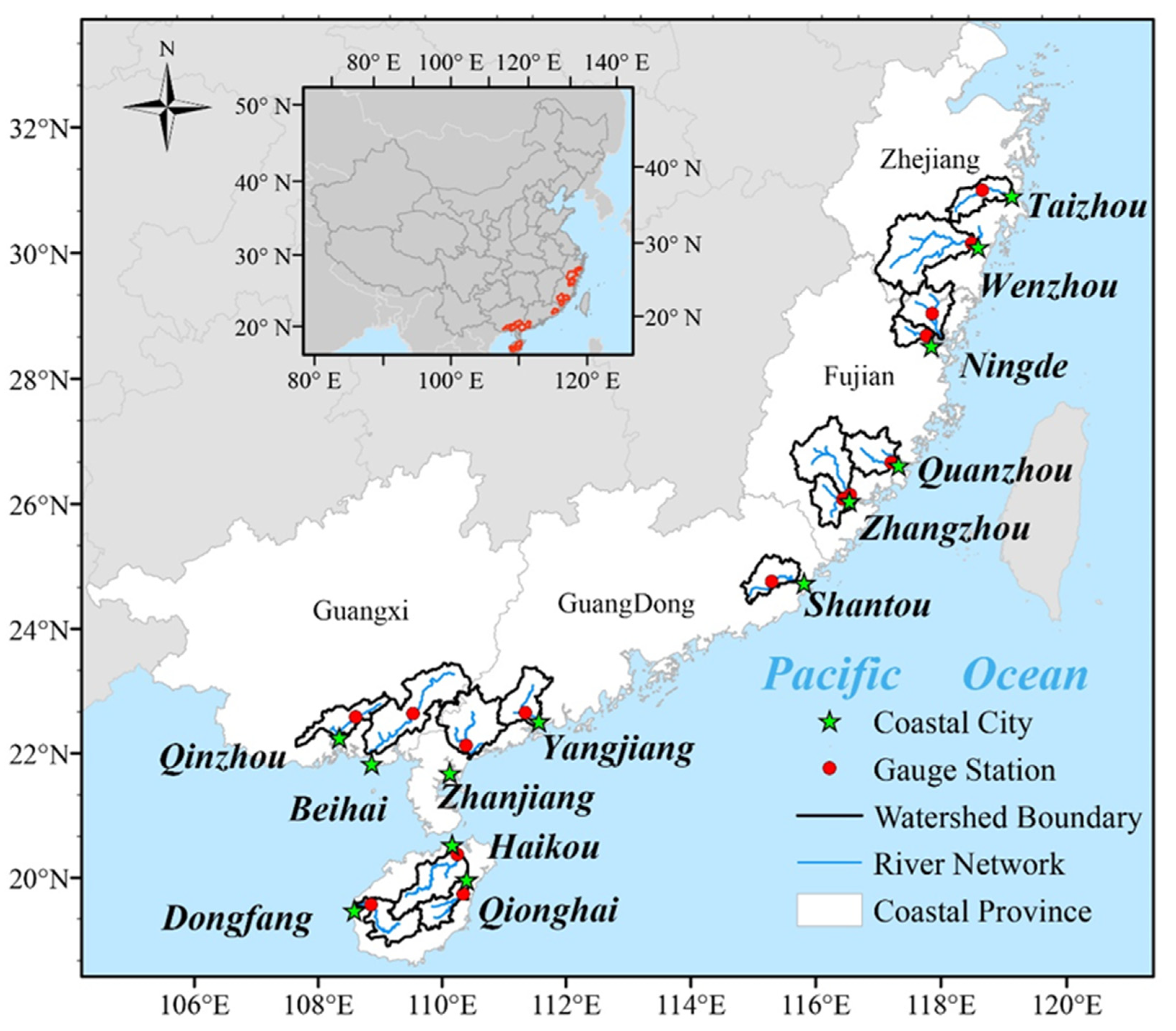
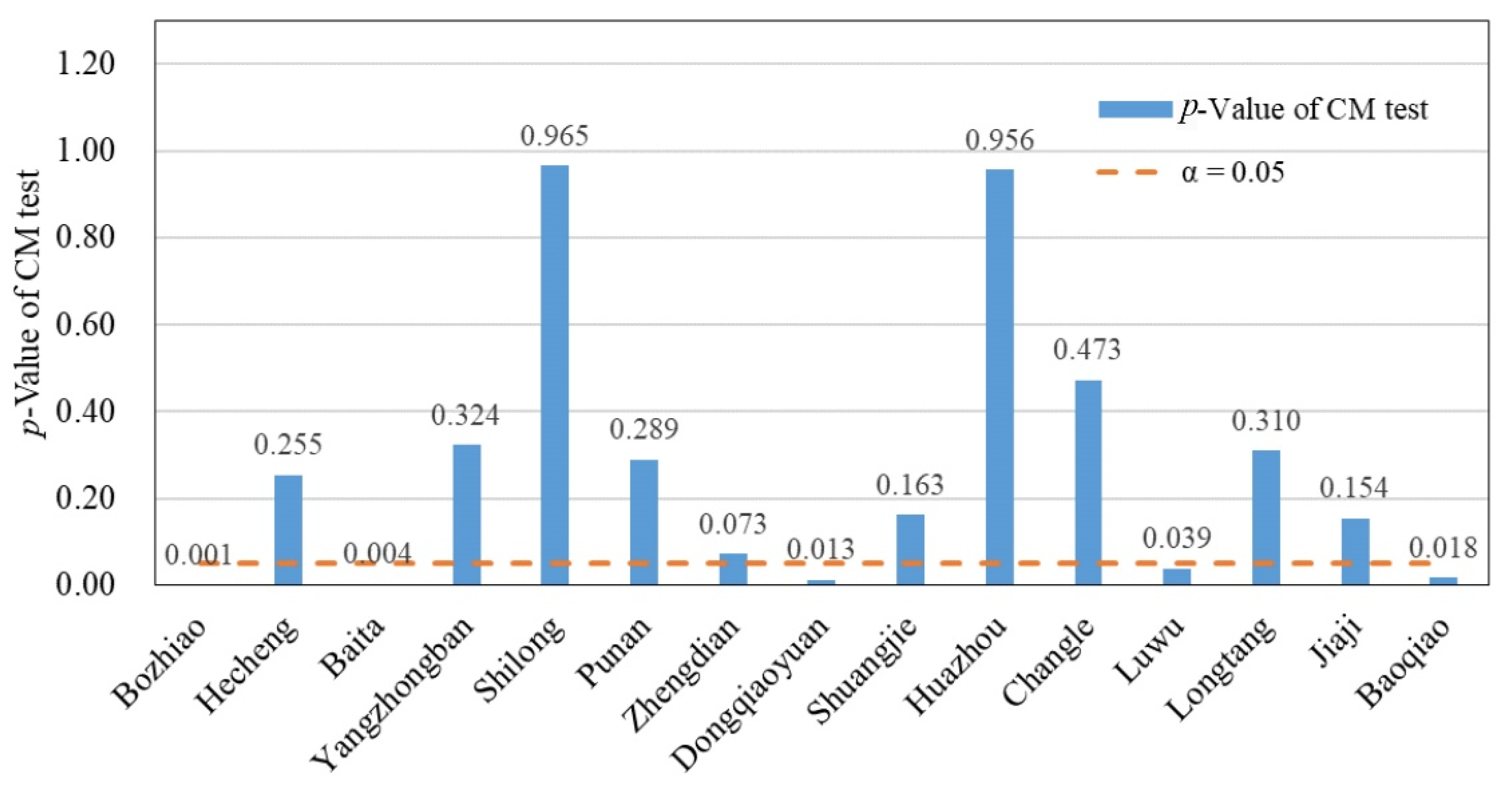
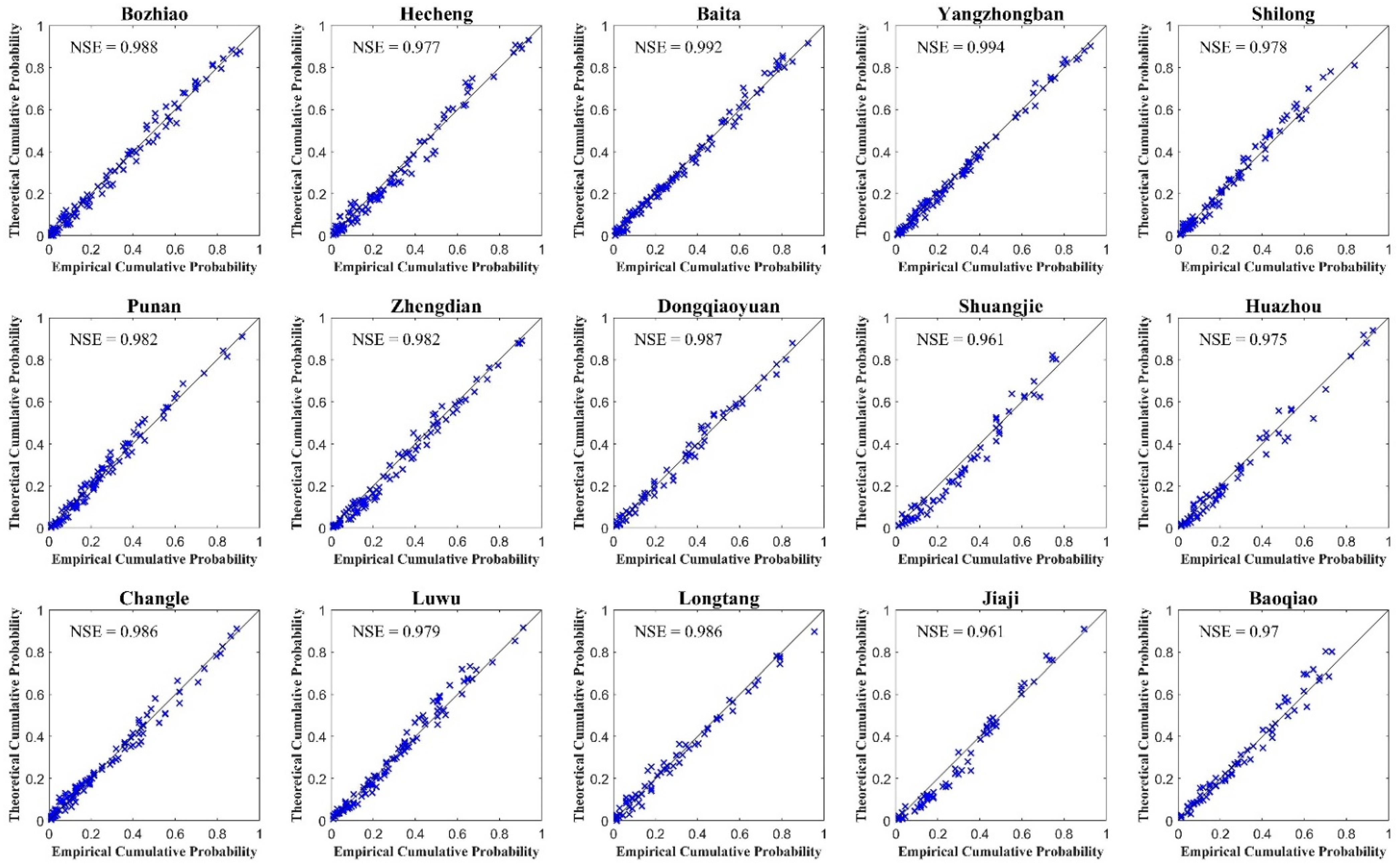
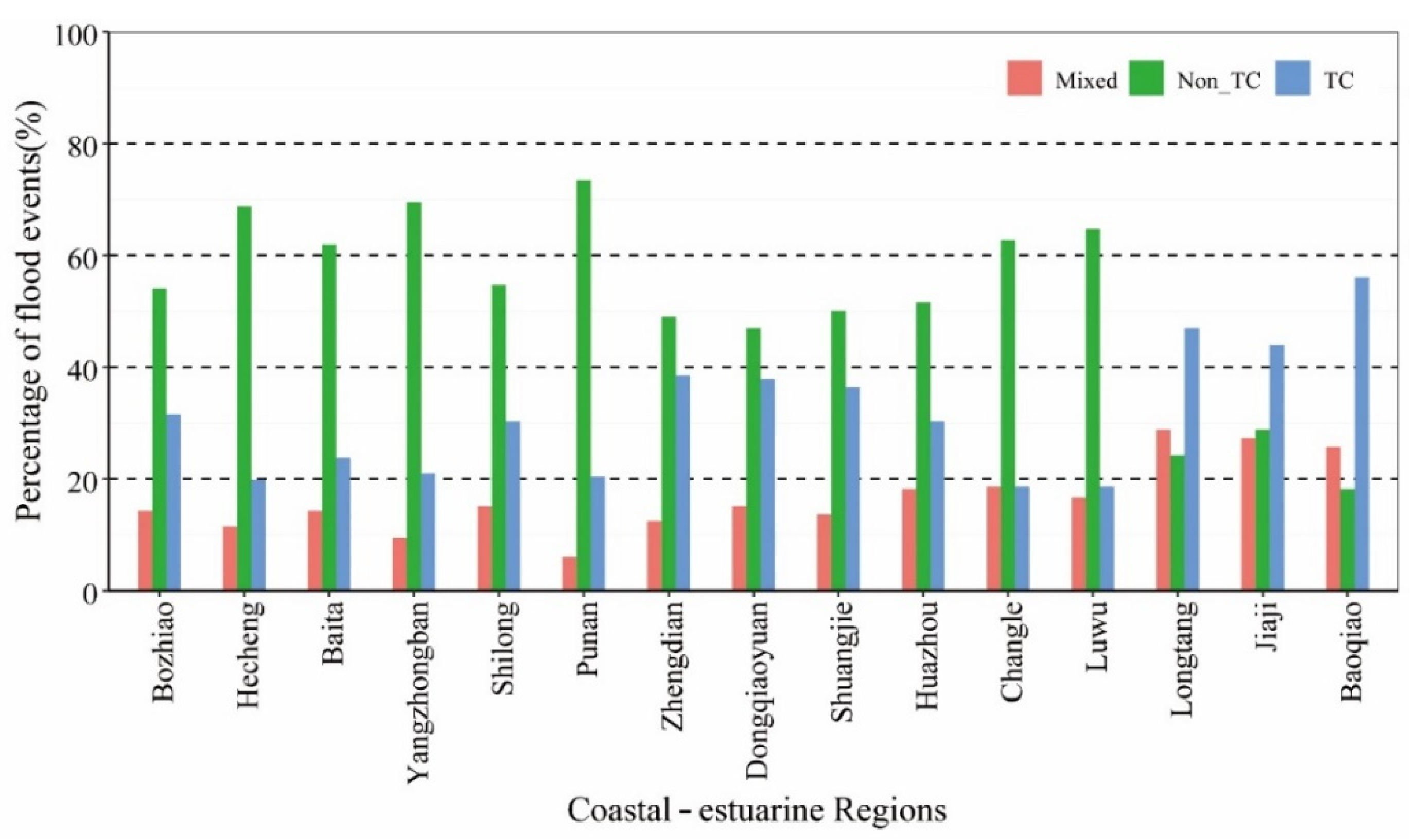

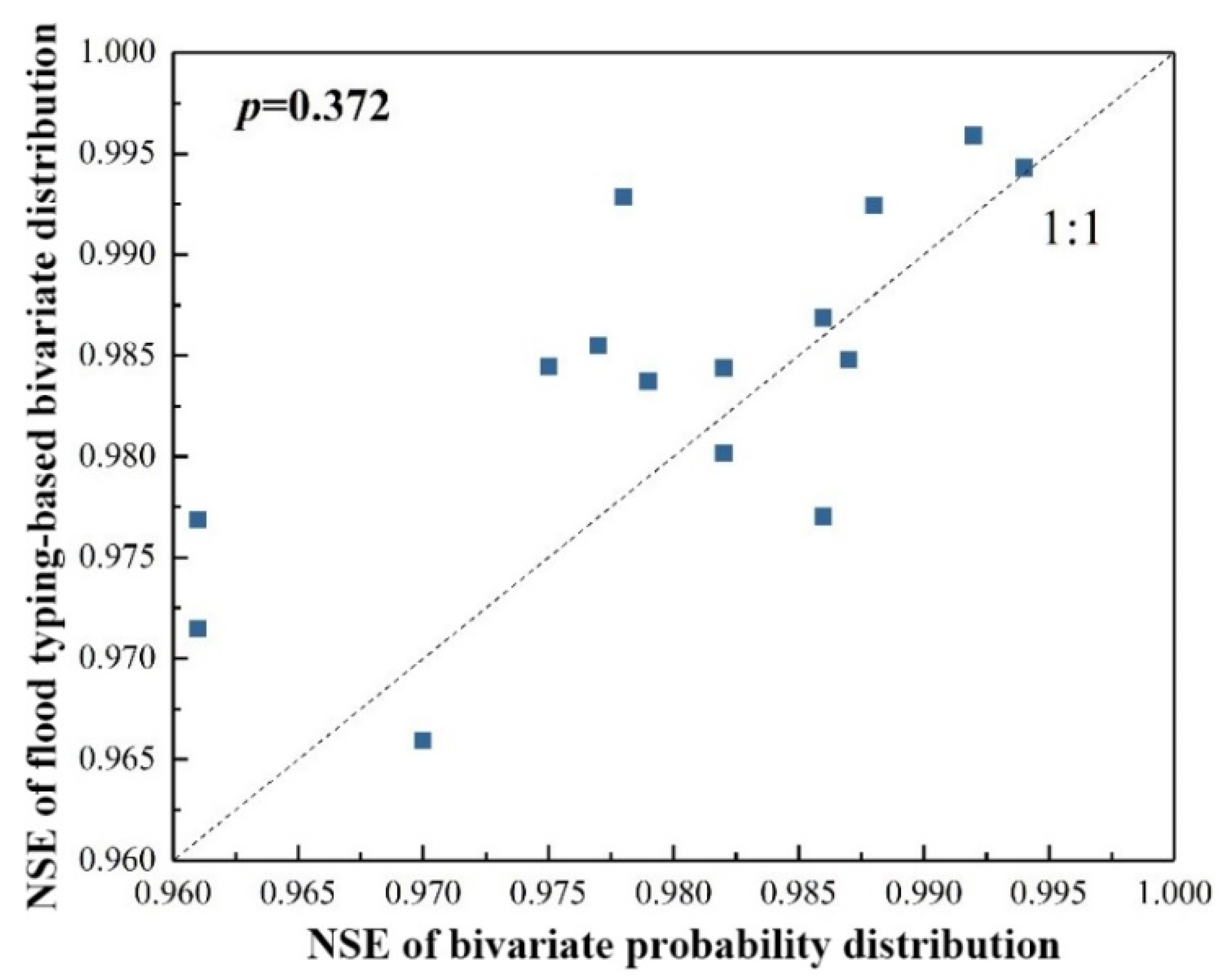

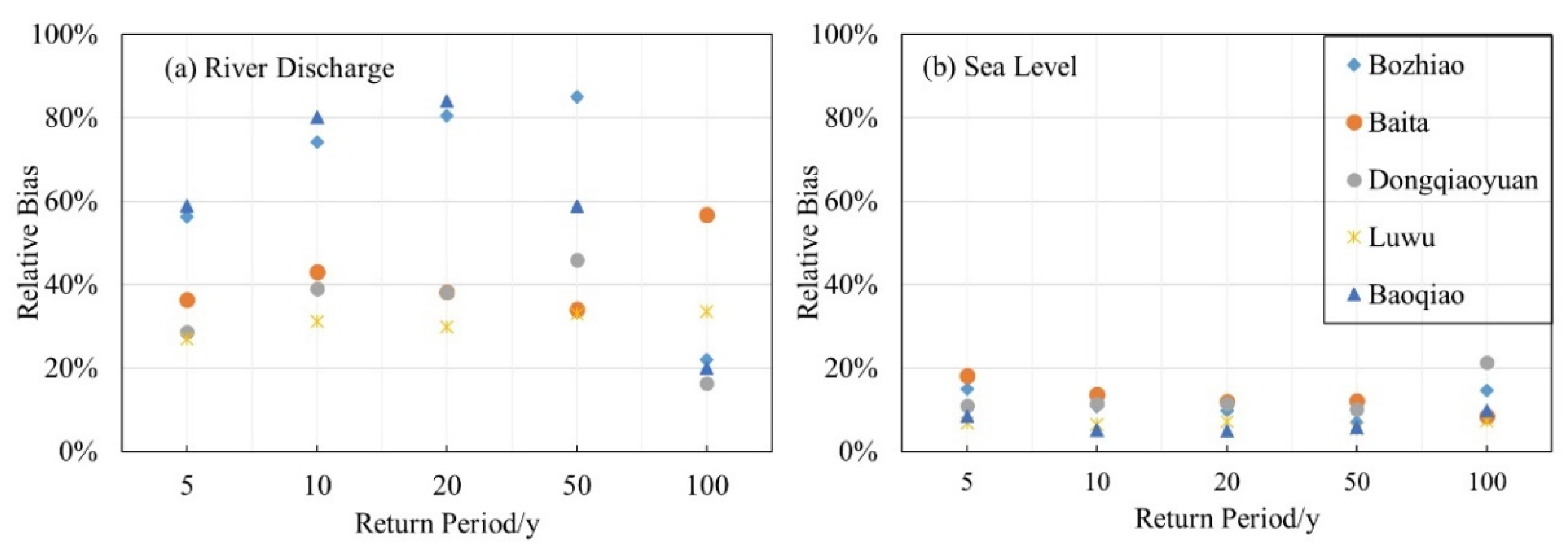
| Region | Coastal City | Gauge Station | River | Drainage Area (km2) | Mean Annual Rainfall (mm) | Data Length (Year) | Percentage of Missing Years (%) |
|---|---|---|---|---|---|---|---|
| Coastal area of China mainland | Taizhou | Bozhiao | Lin River | 2475 | 1635 | 50 | 11 |
| Wenzhou | Hecheng | Ou River | 13,500 | 1745 | 49 | 13 | |
| Ningde | Baita | Jiao River | 3270 | 1949 | 54 | 4 | |
| Ningde | Yangzhongban | Huotong River | 2082 | 1616 | 54 | 4 | |
| Quanzhou | Shilong | Jin River | 5060 | 1650 | 44 | 21 | |
| Zhangzhou | Punan | Jiulong River | 8490 | 1800 | 50 | 11 | |
| Zhangzhou | Zhengdian | Xi River | 3419 | 1400 | 49 | 13 | |
| Shantou | Dongqiaoyuan | Rong River | 2016 | 1200 | 34 | 39 | |
| Yangjiang | Shuangjie | Moyang River | 4345 | 2199 | 34 | 39 | |
| Zhanjiang | Huazhou | Jian River | 6151 | 1883 | 34 | 39 | |
| Beihai | Changle | Nanliu River | 6645 | 1700 | 52 | 7 | |
| Qinzhou | Luwu | Qin River | 1400 | 1658 | 52 | 7 | |
| Hainan Island | Haikou | Longtang | Nandu River | 6841 | 1929 | 34 | 39 |
| Qionghai | Jiaji | Wanquan River | 3236 | 2800 | 34 | 39 | |
| Dongfang | Baoqiao | Canghua River | 4634 | 1530 | 34 | 39 |
| Coastal-Estuarine Region | Number of Data | Kendall Tao Rank Correlation Coefficient | p-Value |
|---|---|---|---|
| Bozhiao | 100 | 0.23 | 0.001 |
| Hecheng | 98 | 0.07 | 0.302 |
| Baita | 108 | 0.16 | 0.013 |
| Yangzhongban | 108 | 0.03 | 0.658 |
| Shilong | 88 | −0.09 | 0.234 |
| Punan | 100 | −0.06 | 0.399 |
| Zhengdian | 98 | 0.10 | 0.164 |
| Dongqiaoyuan | 68 | 0.16 | 0.054 |
| Shua ngjie | 68 | 0.06 | 0.503 |
| Huazhou | 68 | −0.02 | 0.795 |
| Changle | 104 | −0.03 | 0.615 |
| Luwu | 104 | 0.11 | 0.090 |
| Longtang | 68 | 0.08 | 0.376 |
| Jiaji | 68 | 0.10 | 0.264 |
| Baoqiao | 68 | 0.16 | 0.060 |
| Coastal-Estuarine Region | RP/y | Independent Joint Distribution | Best Fitted Copula Function | ||
|---|---|---|---|---|---|
| River Discharge (m3/s) | Sea Level (m) | River Discharge (m3/s) | Sea Level (m) | ||
| Bozhiao | 5 | 3174 | 0.40 | 4960 | 0.46 |
| 10 | 5390 | 0.46 | 9386 | 0.51 | |
| 20 | 9544 | 0.51 | 17,222 | 0.56 | |
| 50 | 21,084 | 0.57 | 39,004 | 0.61 | |
| 100 | 38,996 | 0.61 | 47,587 | 0.70 | |
| Baita | 5 | 3773 | 0.44 | 5147 | 0.52 |
| 10 | 5579 | 0.51 | 7980 | 0.58 | |
| 20 | 8431 | 0.58 | 11,656 | 0.65 | |
| 50 | 14,911 | 0.66 | 19,996 | 0.74 | |
| 100 | 23,243 | 0.71 | 36,452 | 0.77 | |
| Dongqiaoyuan | 5 | 1777 | 0.64 | 2288 | 0.71 |
| 10 | 2432 | 0.70 | 3381 | 0.78 | |
| 20 | 3411 | 0.78 | 4717 | 0.87 | |
| 50 | 5494 | 0.89 | 8015 | 0.98 | |
| 100 | 8013 | 0.98 | 9327 | 1.19 | |
| Luwu | 5 | 1149 | 0.73 | 1460 | 0.78 |
| 10 | 1512 | 0.78 | 1985 | 0.83 | |
| 20 | 1997 | 0.83 | 2595 | 0.89 | |
| 50 | 2899 | 0.91 | 3858 | 0.96 | |
| 100 | 3859 | 0.96 | 5151 | 1.03 | |
| Baoqiao | 5 | 5786 | 0.71 | 9200 | 0.77 |
| 10 | 10,443 | 0.77 | 18,811 | 0.81 | |
| 20 | 19,180 | 0.81 | 35,285 | 0.85 | |
| 50 | 43,487 | 0.87 | 69,044 | 0.92 | |
| 100 | 81,267 | 0.91 | 97,548 | 1.00 | |
Publisher’s Note: MDPI stays neutral with regard to jurisdictional claims in published maps and institutional affiliations. |
© 2022 by the authors. Licensee MDPI, Basel, Switzerland. This article is an open access article distributed under the terms and conditions of the Creative Commons Attribution (CC BY) license (https://creativecommons.org/licenses/by/4.0/).
Share and Cite
Lu, W.; Tang, L.; Yang, D.; Wu, H.; Liu, Z. Compounding Effects of Fluvial Flooding and Storm Tides on Coastal Flooding Risk in the Coastal-Estuarine Region of Southeastern China. Atmosphere 2022, 13, 238. https://doi.org/10.3390/atmos13020238
Lu W, Tang L, Yang D, Wu H, Liu Z. Compounding Effects of Fluvial Flooding and Storm Tides on Coastal Flooding Risk in the Coastal-Estuarine Region of Southeastern China. Atmosphere. 2022; 13(2):238. https://doi.org/10.3390/atmos13020238
Chicago/Turabian StyleLu, Weiwei, Lihua Tang, Dawen Yang, Heng Wu, and Zhiwu Liu. 2022. "Compounding Effects of Fluvial Flooding and Storm Tides on Coastal Flooding Risk in the Coastal-Estuarine Region of Southeastern China" Atmosphere 13, no. 2: 238. https://doi.org/10.3390/atmos13020238
APA StyleLu, W., Tang, L., Yang, D., Wu, H., & Liu, Z. (2022). Compounding Effects of Fluvial Flooding and Storm Tides on Coastal Flooding Risk in the Coastal-Estuarine Region of Southeastern China. Atmosphere, 13(2), 238. https://doi.org/10.3390/atmos13020238






